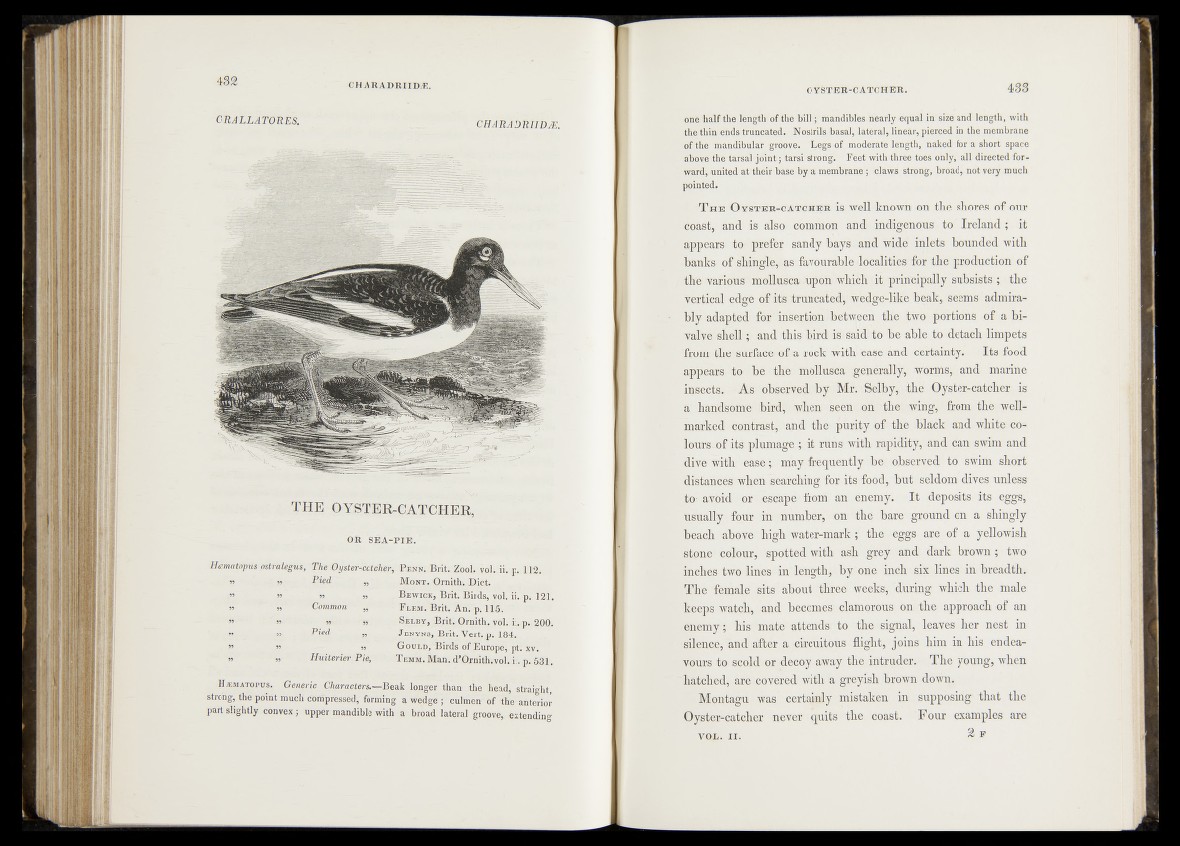
g r a l l a t o u e s . CHARADRIIDJE.
T H E OYSTER-CATCHER,
OR S E A -P IE .
Hamatopus ostralegus, P enjj. Brit.‘Zool.>ol. ib-p..ïl2.
” » Ried „ Mont. Qrnith. Diet.
” » » . B ewick, Brit. Birds, voU ii. p. 121.
y> n Common „ Flem. Brit. An. p. 115. "
” » » -t» Selby, Brit; Qrnith. vol. ii. p. 200.
« » Ri^d ' : Jenyns, Brit, Vert.p. 184. .
” » — n Goüï,d/ Birds'of Europe, pt: xv.
» » Huiterier Pie, Temm. Man. d'Óxnitibuvol. ii. p. 531.
H /ematopus. Generic Gi^racters.-r-Beak longer thann-the head, straight,
strong, the point much confpressed, forming a wedge ; cultaen'of the - anterior
part slightly convex j upper mandible with a broad lateral groove, extending
one half thé lèngthf of-ïhe b ill; mandibles nearly equal in size and length, with
M^MiM^^Sfttncated. basal, lateral, linehr, pierced in the membrane
of the ■'mandibular groove.'* Legs of moderate length, naked for a short space
above the i a f s a n j ) ^tarsi-etrotfg;'^'Fèet with three toes only, all directed forward,
united at their base -by a membtane; claws strong, broad, not very much
■ T h e O y s t e r - cAt c h e r is* well known on the shores of our
Coast, and ^®ls;a'a e^m^on and- .andigenousyto Ireland; it
appears- tog prefer san d ^b a^ jan d wide inlets bounded with
banks of sMfigié,las faYMiable-dó'eaMties, • for the- production of
tfhè^aii^tó moUaiscasupon which it principally subsists ; the
■Wertidal- ’edge of ité^’lruitcatedy Yfe'd^ïM^ke beak, seems - admirab
ly adapted fox'iinlertipi J b e t w e ó n two portions .of a bi-
valye shfel|.;-3 and"' thi^lbirt' 'feable^to - detach limpets
from the'.SilfiPaée-of a rock with'ease and certainty. Its^food
appears 4of|$|l!the mollusca 'generaliy, worms, - and- marine
' observed /by Mr. ;Selby,óihë Oyster.-catcher is
a handsornC »-bird, when ftsCfïlJ oh- >the';whng, from thWwell-
marked %^r&t$afnd the purity ó f thé «bhfékl and,-white co-
l&urs-of III plumage ; it' runs With rapidity/and can swim and
dive with,J,'rea'se; may frequently>be>, Mh'seived to swim short
«stances' when ’searcMn^-for-its food* bufcseldom' dives unless
to--avoid oir-oscape' from an énemy|As It .deposits its eggs,
usually fèhr 'in number, on the bare ground on a shingly
beach above high Water-mark { the - eggs are of a yellowish
stvone? Colour, -spotted with ash grey and dark brown ; tWo
inches two line's- in lengthy one inch ’ sih^l'in'es-in breadth.
The female sits "about three Week's', "during which the male
keeps watch, and becomes clamorous/cm the approach o f an
Cnerny; his mate attend^è%h& signal, leaves her -nest in
'silence, and after a circuitous flight, joins him in his endeavours
to scold or decoy away the intruder;' The young, when
■hatched, are-icovéred with-a greyish brown down.
Montagu was certainly mistaken in supposing that the
Oyster-catcher never quits the coast. Four examples are
VOL. II. 2 F